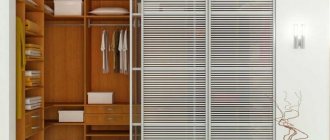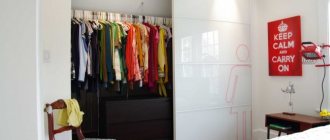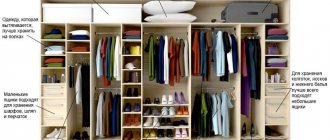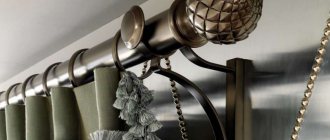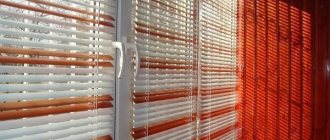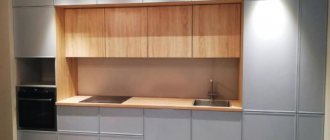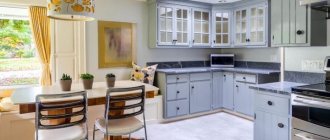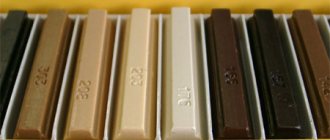Types of furniture handles
Kitchen handles are divided into overhead, mortise and profile. Invoices, in turn, are divided into several types:
- hanging - rings and drops;
- buttons;
- shells;
- staples;
- roof rails
In addition, front fittings can be divided into solid, prefabricated and combined products. Solid ones are more reliable, because the fewer joints, the more difficult it is to damage the products, and dirt will not accumulate at the joints, which is not easy to clean.
Profile and mortise design
The profile is hidden behind the facade, the size of the facade is made smaller in height so that there is a gap at the top, making it possible to hook the profile and open the door. In Soviet times, almost everyone had profile models for kitchen furniture. The profile is rapidly making a comeback and gaining popularity in modern kitchens.
For mortise models, recesses are milled in the facades for installation. The housing is built inside the door and does not interfere with movement around the kitchen. Such furniture options are quite reliable, convenient and practical.
Hanging rings and drops
Hanging handles have one fastening, so they are rarely used in the kitchen.
Pendant handles appear as a ring or teardrop-shaped nub that connects to a patterned metal trim and is usually secured with a single universal bolt. Hanging models are not the best choice for kitchen furniture. When opening, it is not immediately possible to grab the hanging element and pull it. Fingers simply slide off the teardrop-shaped part.
Button as a view
The button is a body with or without a leg, with one fastening to the facade. Push-button housings come in different shapes: round, square, rectangular, oval, spherical and in the form of decorative elements - flowers, openwork patterns. The leg can be attached directly to the facade or pre-connected to an overlay, like hanging fittings.
First let's decide
Only a few have thought about how a handle differs from a handle. The handle is the part of the object that is held by the hand, and the handle is the part of the hand tool or weapon by which it is held. Such interpretations are offered in dictionaries. In fact, clearer definitions would be: · Handle (hilt) is a part of an object specifically designed to be grasped by the hand and held while performing some indefinitely long action, for example:
- the handle of a hand-held mechanized tool (drill, air gun, etc.), the handle of a hammer, knife, chisel, etc., by which they are held during operation;
- A handle is an object or part of it specially designed for grasping, grasping or pressing on it with the hand when performing some short-term action, for example, for opening something: the handle of a door, window, cabinet drawer, etc.;
Standard sizes
Profiles are usually installed along the entire length, less often along the height of the facade, and the size of the profile corresponds to the width or height of the door. These pens look modern and are easy to care for.
The dimensions of the bracket and railing for installation are standard: 64, 96, 128, 160, 192, 224 mm and then after 32 to 1056 mm. A size of 128 mm or more is considered more convenient for gripping with a standard palm. Long handles are usually placed on wide doors and drawers or vertically on hinged fronts. If you want to change one type of fittings to another, you can select handles for the kitchen set from a catalog from a specific size range.
Rails allow you to screw your own handle onto each façade depending on its width. But don’t overuse the number of different sizes. This will bring chaos to the appearance of the kitchen.
When choosing one size or another, one must remember that massive products on narrow door facades will look heavy, especially in a small room.
Installation Features
To ensure the safety, security and longevity of your cabinet, it is important to install the hardware correctly. Necessary materials:
- construction meter;
- square;
- marker;
- screwdriver or screwdriver.
The handle needs to be attached to the front part of the facade. Marking and installation algorithm:
- Mark the place where the part will be attached.
- Draw a straight line so that it is parallel to the place where the fittings will be located.
- Draw a straight line perpendicular to the previous one.
- From the point of intersection of the two lines, measure the center distance.
- Drill a hole for the handles, please note that you need to drill carefully, slowly, only with a sharp drill. Otherwise, you can damage the door facade (tear out particles of the laminate).
- Insert the screws into the hole, insert the handle and screw it on.
This method of marking and installation is suitable for any front fittings, excluding handles, brackets and profiles; they must be fixed with a self-tapping screw on the outside of the furniture.
Style orientation of furniture
Each style has its own type of fittings.
For classic furniture, an option with a ceramic insert is used, on which a neat pattern is applied. It is also possible to install a bracket with an openwork pattern. The material used to cover kitchen furniture handles is bronze or copper. Hanging rings or drops can be used on small drawer fronts, on bottle holders and on narrow hinged doors. The application of characteristic darkening, the so-called artificial aging (patina), is often used to decorate a classic kitchen and is highly valued in the furniture fittings market.
The Provence style is also relevant today . It goes well with metal push-button options and staples coated with enamel in calm light tones or steel or nickel color. Vintage colored buttons go perfectly with a kitchen with wooden doors. Handles for kitchen furniture with bronze and ceramic inserts can also be screwed to Provence style facades. The same options will look good on country-style facades.
For minimalism or high-tech style, end profiles for kitchen facades or mortise products are perfect for installation. Such fittings are almost invisible, and the facade looks smooth, as if without a handle. The profile is not only ideal for use, but also modern.
Which water heater for the kitchen is better to choose: instantaneous or storage?
- Avoid plastic. No matter how beautiful it may be, it is always of low quality and questionable service life;
- If wooden facades are used, then wooden handles are also suitable;
- Metal is rightly considered the best option. Moreover, pure metal is rarely used because it is expensive. But alloys are used everywhere.
There are also unique products made of glass, as well as ceramic models and leather handles that have interesting features.
Fittings made from high-quality materials will be more expensive, but this is due to the appropriate level of performance, long service life and practicality.
This is interesting: Assortment of furniture lamps, examples of design and placement
Manufacturing materials
Metal handles are considered durable and reliable. They can be made of various alloys, with forging and casting elements. Ceramic products allow you to create exceptional masterpieces in terms of shape and decorative design. They are also quite durable, but can be damaged. Plastic is the most affordable option, but such a product will not last long. This is not the best choice for the kitchen.
Models with rhinestones have a small element of unreliability in the area where the crystal is attached to the body of the pen.
The location of the outermost kitchen cabinet against the wall suggests a vertical placement of the handle rather than a horizontal one. This will help to avoid the fittings from resting on the wall when opening the door.
Criterias of choice
When choosing furniture handles for cabinets, you need to consider the following criteria:
- Convenience. It’s a pleasure to handle the part and it’s comfortable to open any doors. Thanks to its optimal size, the product fits comfortably in the palm of your hand and does not cut with sharp corners.
- Style. The cabinet handle should complement the overall design of the room. In combination with furniture, fittings make the design complete.
- Price. The more famous the brand, the more expensive the products are, but the quality of the fittings is also higher.
- Practicality. The parts are made of high-quality and environmentally friendly material and do not deform during operation. You should choose models that are easy to clean.
Every year, the accessories market is replenished with products of the most intricate shapes and style solutions. Furniture without clamps, fasteners, handles and other fittings cannot exist. Thanks to these products, you can create stylish, modern interior items.
Convenience
Style
Price
Practicality
Mistakes when designing a custom kitchen
When creating a kitchen project, take as a basis how you usually work, in what sequence you perform actions:
- Washing products;
- Cooking;
- Heat treatment.
In doing so, be sure to consider the following important points:
- The place where the equipment will be located;
- Location and number of outlets;
- Module functionality, filling, storage;
- Headset dimensions;
- Design features (texture, color) from a practical point of view.
Let's look at the last point in more detail:
- open shelves and display cabinets - such furniture will require cleaning more often than could be the case with closed facades. Be sure to take this into account when ordering a kitchen;
- a dark countertop, uniform in color, glossy - on such surfaces, any stains are also more noticeable. Conversely, a tabletop with a non-uniform pattern and inclusions will be much more convenient in this regard.
Decoration methods
Objectively, metal fittings are the most preferable option.
For the production of handles, Zamak and Znal alloys are mainly used.
In the first case, it is a combination of copper, magnesium, aluminum and zinc. The second alloy is simpler and cheaper because it includes aluminum and zinc.
Since not everyone can afford high-quality metal fittings, and their production is expensive, companies are reducing costs. For this purpose, inexpensive alloys are used, but they are coated with sputtering. This is how bronze, copper, gold, chrome, and silver handles are obtained.
When choosing, pay attention to exactly how the coating is applied. There are 2 methods.
[adv1]
- Electroplating. This is a very thin metal film that is applied by electroplating. Extremely high quality and reliable coating. Has high wear resistance and corrosion protection;
- Regular spraying. It is made on the basis of a paint coating. Cheap, although it looks solid from the outside. This coating does not last long. Especially in the kitchen, where there is high humidity and constant temperature changes.
If finances allow, take handles based on Zamak alloy with galvanic decorative coating.
Dampers
The damper is a small but essential item. This is a kind of shock absorber for furniture, limiting the door open upward. The door is fixed in one position, and a person does not need to hold it.
The damper operates smoothly and silently. Often included with a door closer and prevents the door from opening too quickly. They are classified by power, which is measured in Newtons. A façade width of up to 50 cm requires one shock absorber (at 60H).
Dampers can be overhead (the easiest to install, with stops) and mortise (requiring a hole). Based on the design mechanism, there are hydraulic (cylinder with pistons) and pneumatic (used with lifts).
General recommendations
From all of the above, it is clear that the lack of familiar fittings gives rise to one significant problem: the facades of the furniture quickly become dirty. To solve this problem, experts advise choosing light-colored sets and purchasing kitchen cabinets without handles in white, blue-gray or light gray with a semi-gloss texture. Satin facades with a matte, slightly rough surface are easier to clean.
The most impractical variation is gloss black. You will have to constantly take care of this model. Any fingerprint will spoil the appearance of the product. You can buy such furniture if you can pay for the services of a visiting housekeeper or an apartment cleaning assistant.
Not everyone is mentally ready to completely give up their usual pens. In such a situation, experts advise using a compromise: making the upper cabinets without fittings and equipping only the lower tier with handles. Photos of such headsets show how successful the proposed solution can be.
The top has no handles, the lower cabinets have an integrated profile instead of handles Source twgram.me
Modern kitchen furniture manufacturers like to combine and use several opening and closing systems at once. For example, they equip the upper cabinets with a “Push-open” mechanism, and the lower ones with “Gola” profiles.
How to choose handles for a kitchen set in the shape of a shell
They got their name because of their characteristic shape. Most often they are made of chrome, nickel, steel or copper. The metal provides sufficient strength so as not to deform when opening. Installed horizontally. A person’s hand should easily enter the sash from the inside and pull it towards itself. The front surface remains clean. Securely fastened with a few bolts. There are round and rectangular shapes. The latter are combined with modern style sets. Traditional shells visually soften strict geometric shapes and suit Provence, Baroque, and Art Nouveau styles.
Lifting mechanisms
These are façade lifts that allow the heaviest sashes to be lifted effortlessly. They are the best option for cabinets located at height, for wide sets with one long facade or for double doors of multi-tiered wall cabinets.
This mechanism is able to provide a good overview of the entire contents of the locker. In this case, the free space is not closed, as is the case with swing doors.
The most common varieties:
- When opened, two doors fold in the middle and rise (the so-called accordion).
- Folding, suitable for the upper tier of furniture. The door hinges upward and is suitable for both a solid cabinet and a set with an overhanging visor.
- The façade opens upward parallel to the body. It is as convenient as possible and can be installed on both upper and lower cabinets.
- Perpendicular lift.
